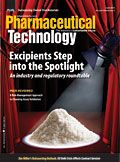Making a Difference
A PharmTech forum to discuss the industry's efforts in corporate social responsibility and sustainability.
Making a difference. We have heard that phrase many times, but how does it translate to our individual and collective lives? Can we truly effectuate positive change? Can one person really have an impact?
To answer those questions, we need only turn to our daily tasks in the pharmaceutical industry. Bringing a molecule to market is not only a scientific accomplishment but an immensely collaborative effort. We all know the challenges. It takes 10–15 years to bring a new drug to market at an estimated average cost of $1.2–1.3 billion. Only one out of thousands of compounds tested will make it through clinical development and be approved. There is more failure than success. So why continue?

Patricia Van Arnum
Certainly there is financial benefit, but there is also the reward that comes with knowing that one of those drugs that we may work on will have an impact—will meaningfully improve the quality of life for someone. Each person—the medicinal chemist discovering an initial hit and optimizing a lead, the synthetic chemist developing a process route, the formulation scientist devising a drug-delivery system, the engineer scaling up the process, the regulatory expert ensuring product quality, and the production manager manufacturing the drug substance or drug product—plays a part in bringing that treatment to those that need it. They all make a difference.
These efforts make me consider the perspectives that Albert Schweitzer, the Nobel Peace Prize laureate, physician, and humanitarian, offered on his work and the work of others: "Wherever a man turns, he can find someone who needs him....Do something wonderful, people may imitate it."
It is in that same spirit of realizing that all efforts, both individual and collective, large or small, have import and do indeed matter, that beginning with the June issue of Sourcing and Management, an eNewsletter of Pharmaceutical Technology, we will bring to you the work, approaches, and ideas of those seeking to make a difference. We will discuss the humanitarian, philanthropic, and sustainability efforts of the pharmaceutical industry and the activities of other business sectors, scientific, trade, and professional associations, nongovernmental organizations (NGOs), and individuals. Just as we examine company strategy, scientific approaches, and business and technical challenges, we will take a similar approach in discussing the contributions, models, and new perspectives in corporate social responsibility and related philanthropic and humanitarian efforts as a means of recognizing valuable work, generating dialogue, and learning how and what we can do.
We begin our coverage with two stories: a discussion of the Science and Human Rights Program of the American Association for the Advancement of Science (AAAS) and the pharmaceutical industry's relief efforts in Haiti. We will learn how the AAAS, an organization of 262 affiliated academic, professional, and scientific organizations, which together serve 10 million members, is forwarding its goal of using science as an enabler to realizing human rights, including how scientific groups and individuals can participate in that goal. We will speak with the major pharmaceutical companies about how they have been able to help with the relief efforts in Haiti and with NGOs on the situation in Haiti.
In upcoming issues of Sourcing and Management, we will also look at how business models can be applied to help alleviate poverty. In the July issue, we will examine the work of the Acumen Fund, a nonprofit venture capital fund that is using "patient capital," or debt/equity investment in enterprises that provide low-income consumers with access to healthcare, water, housing, alternative energy, or agricultural products using an economically sustainable approach. And in our September CPhI/ICSE print supplement, we will have a discussion with the pharmaceutical majors, other business leaders, and NGOs on global health initiatives and ways to advance and increase access to education.
Having been a business and science journalist for nearly 20 years, I am accustomed to receiving daily doses of news that show how things can work and how things do not. Any reasoned person knows there are challenges to every endeavor and limitations to his own knowledge and understanding. But there is one thing that I know with absolute certainty: when people of good will come together and lend their talents, efforts, resources, and perhaps most important, their concern, solutions can be found. We look forward to sharing with you the ideas and work behind those efforts.
Patricia Van Arnum is a senior editor of Pharmaceutical Technology.

Transformations in Drug Development for Cell and Gene Therapies
March 28th 2025As a recognized leader in immunophenotyping for clinical trials, Kevin Lang from PPD discusses how spectral flow cytometry is transforming drug development, particularly in cell and gene therapies like CAR-T. He also dives into his award-winning research, including his 2024 WRIB Poster Award-winning work, and his insights from presenting at AAPS PharmSci360.
Advancing Clinical Trials with Spectral Flow Cytometry: A Conversation with Kevin Lang
March 28th 2025As a recognized leader in immunophenotyping for clinical trials, Kevin Lang from PPD discusses how spectral flow cytometry is transforming drug development, particularly in cell and gene therapies like CAR-T. He also dives into his award-winning research, including his 2024 WRIB Poster Award-winning work, and his insights from presenting at AAPS PharmSci360.
PacBio Chosen as Tech Partner for Global Alzheimer’s Disease Research Project
April 23rd 2025The project, the North African Dementia Registry, will unite multiple entities for the purpose of developing a comprehensive dataset to advance the research community’s understanding of Alzheimer’s disease and other dementias in diverse populations.